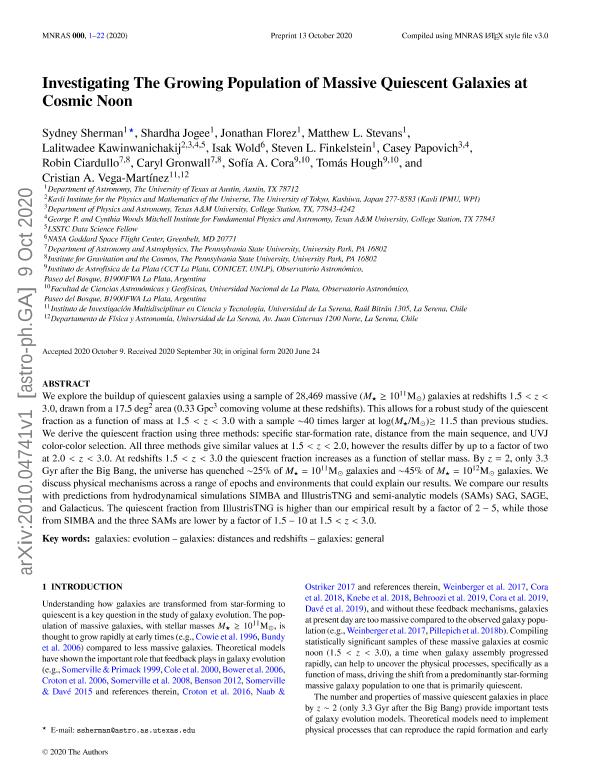Mostrar el registro sencillo del ítem
dc.contributor.author
Sherman, Sydney
dc.contributor.author
Jogee, Shardha
dc.contributor.author
Florez, Jonathan
dc.contributor.author
Stevans, Matthew L
dc.contributor.author
Kawinwanichakij, Lalitwadee
dc.contributor.author
Wold, Isak
dc.contributor.author
Finkelstein, Steven L
dc.contributor.author
Papovich, Casey
dc.contributor.author
Ciardullo, Robin
dc.contributor.author
Gronwall, Caryl
dc.contributor.author
Cora, Sofia Alejandra

dc.contributor.author
Hough, Tomas

dc.contributor.author
Vega Martínez, Cristian Antonio

dc.date.available
2021-09-30T13:26:30Z
dc.date.issued
2020-12
dc.identifier.citation
Sherman, Sydney; Jogee, Shardha; Florez, Jonathan; Stevans, Matthew L; Kawinwanichakij, Lalitwadee; et al.; Investigating the growing population of massive quiescent galaxies at cosmic noon; Wiley Blackwell Publishing, Inc; Monthly Notices of the Royal Astronomical Society; 499; 3; 12-2020; 4239-4260
dc.identifier.issn
0035-8711
dc.identifier.uri
http://hdl.handle.net/11336/142047
dc.description.abstract
We explore the build-up of quiescent galaxies using a sample of 28 469 massive (M⋆ ≥ 1011 M☉) galaxies at redshifts 1.5 < zz < 3.0, drawn from a 17.5 deg2 area (0.33 Gpc3 comoving volume at these redshifts). This allows for a robust study of the quiescent fraction as a function of mass at 1.5 < zz < 3.0 with a sample ∼40 times larger at log(M⋆/ M⊙)≥11.5M⊙)≥11.5 than previous studies. We derive the quiescent fraction using three methods: specific star formation rate, distance from the main sequence, and UVJ colour-colour selection. All three methods give similar values at 1.5 < zz < 2.0, however the results differ by up to a factor of 2 at 2.0 < zz < 3.0. At redshifts 1.5 < zz < 3.0, the quiescent fraction increases as a function of stellar mass. By zz = 2, only 3.3 Gyr after the big bang, the universe has quenched ∼25 per cent of M⋆ = 1011 M☉ galaxies and ∼45 per cent of M⋆ = 1012 M☉ galaxies. We discuss physical mechanisms across a range of epochs and environments that could explain our results. We compare our results with predictions from hydrodynamical simulations SIMBA and IllustrisTNG and semi-analytic models (SAMs) SAG, SAGE, and Galacticus. The quiescent fraction from IllustrisTNG is higher than our empirical result by a factor of 2-5, while those from SIMBA and the three SAMs are lower by a factor of 1.5-10 at 1.5 < zz < 3.0
dc.format
application/pdf
dc.language.iso
eng
dc.publisher
Wiley Blackwell Publishing, Inc

dc.rights
info:eu-repo/semantics/openAccess
dc.rights.uri
https://creativecommons.org/licenses/by-nc-sa/2.5/ar/
dc.subject
galaxies: distances and redshifts
dc.subject
galaxies: evolution
dc.subject
galaxies: general
dc.subject
Astrophysics - Astrophysics of Galaxies
dc.subject.classification
Astronomía

dc.subject.classification
Ciencias Físicas

dc.subject.classification
CIENCIAS NATURALES Y EXACTAS

dc.title
Investigating the growing population of massive quiescent galaxies at cosmic noon
dc.type
info:eu-repo/semantics/article
dc.type
info:ar-repo/semantics/artículo
dc.type
info:eu-repo/semantics/publishedVersion
dc.date.updated
2021-07-01T14:59:29Z
dc.journal.volume
499
dc.journal.number
3
dc.journal.pagination
4239-4260
dc.journal.pais
Reino Unido

dc.description.fil
Fil: Sherman, Sydney. Department Of Astronomy; Estados Unidos
dc.description.fil
Fil: Jogee, Shardha. Department Of Astronomy; Estados Unidos
dc.description.fil
Fil: Florez, Jonathan. Department Of Astronomy; Estados Unidos
dc.description.fil
Fil: Stevans, Matthew L. Department Of Astronomy; Estados Unidos
dc.description.fil
Fil: Kawinwanichakij, Lalitwadee. Kavli Institute For The Physics And Mathematics Of The; Japón
dc.description.fil
Fil: Wold, Isak. Nasa Goddard Space Flight Center; Estados Unidos
dc.description.fil
Fil: Finkelstein, Steven L. Department Of Astronomy; Estados Unidos
dc.description.fil
Fil: Papovich, Casey. Department Of Physics And Astronomy; Estados Unidos
dc.description.fil
Fil: Ciardullo, Robin. Department Of Astronomy And Astrophysics; Estados Unidos
dc.description.fil
Fil: Gronwall, Caryl. Department Of Astronomy And Astrophysics; Estados Unidos
dc.description.fil
Fil: Cora, Sofia Alejandra. Consejo Nacional de Investigaciones Científicas y Técnicas. Centro Científico Tecnológico Conicet - La Plata. Instituto de Astrofísica La Plata. Universidad Nacional de La Plata. Facultad de Ciencias Astronómicas y Geofísicas. Instituto de Astrofísica La Plata; Argentina
dc.description.fil
Fil: Hough, Tomas. Consejo Nacional de Investigaciones Científicas y Técnicas. Centro Científico Tecnológico Conicet - La Plata. Instituto de Astrofísica La Plata. Universidad Nacional de La Plata. Facultad de Ciencias Astronómicas y Geofísicas. Instituto de Astrofísica La Plata; Argentina
dc.description.fil
Fil: Vega Martínez, Cristian Antonio. Instituto de Investigación Multidisciplinar En Ciencia; Chile
dc.journal.title
Monthly Notices of the Royal Astronomical Society

dc.relation.alternativeid
info:eu-repo/semantics/altIdentifier/url/https://academic.oup.com/mnras/article/499/3/4239/5924472
dc.relation.alternativeid
info:eu-repo/semantics/altIdentifier/doi/https://doi.org/10.1093/mnras/staa3167
Archivos asociados
